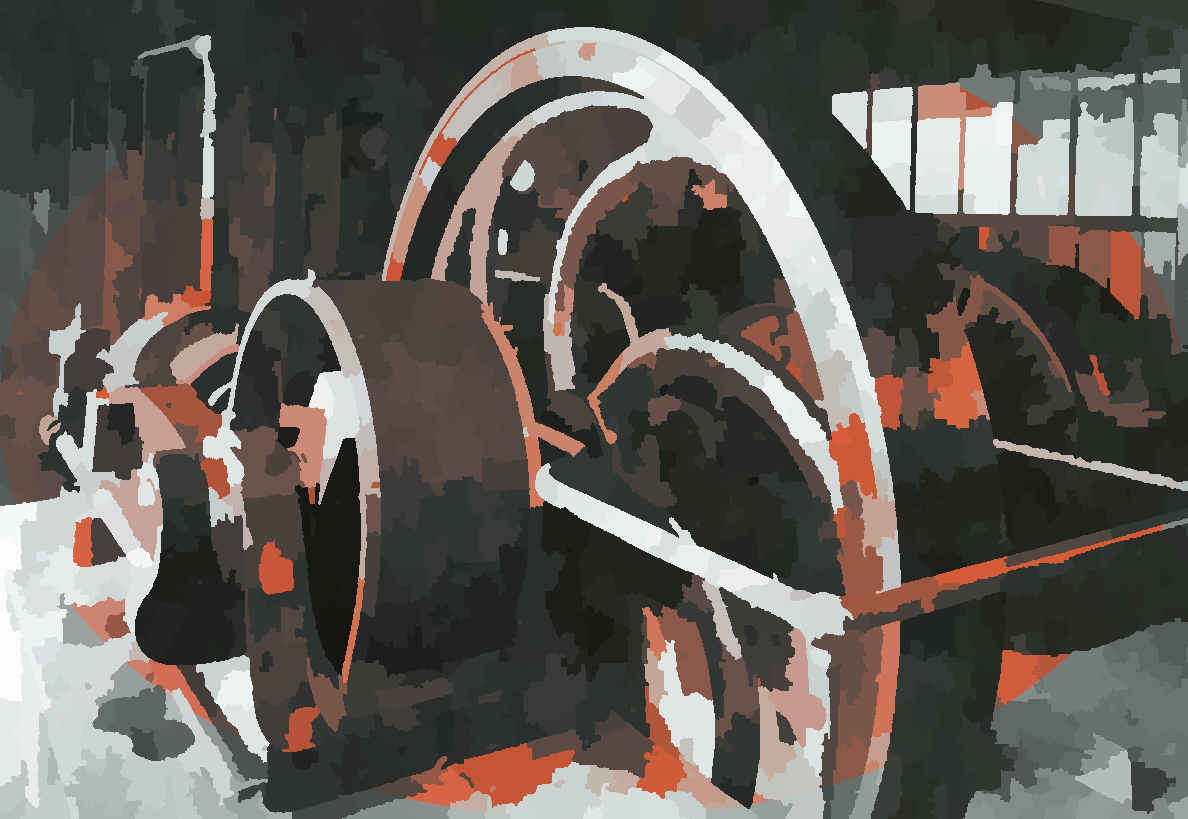|
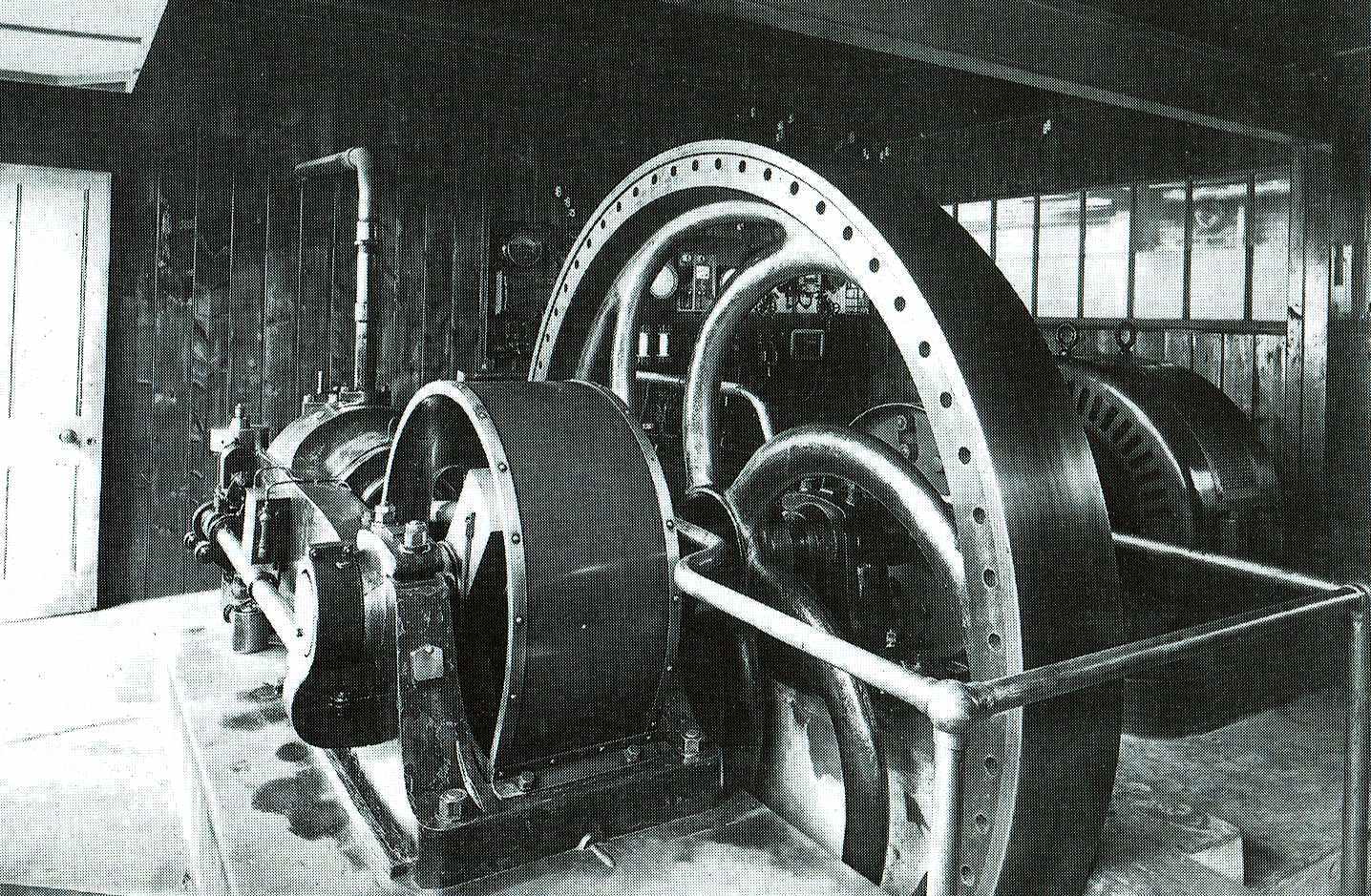
It
was either fated, or the most incredible set of coincidences, that
brought the Generating Station's savoir together. For sure, without him,
Nikolai Askaroff, had it in mind to demolish what he saw as a
liability. That was until he was running short of change, and wanted to
secure the skills of his best decorator & handyman.
One fine summer afternoon in June of 1997,
Alex Askaroff, a great friend of
Victor's from their days at Eastbourne College of Further Education, came rushing up the drive in Lime Park in his trusty Range Rover. For many years Alex had run a mobile sewing machine repair business, which took him far and wide across
Sussex on a regular basis, thus he met a fair few people over the years. He is one of the very finest sewing machine engineers and an authority on many antique makes. In fact he has one of the biggest private collections of sewing machines that
weve ever seen in his private museum.
As the dust settled Victor could see that Alexs face was beaming with rather more enthusiasm than usual. He barely took the time to switch off the engine before leaping from the cab in his rush to impart his news. Alex had just serviced a sewing machine for a lady near
Bexhill. Apparently her husband had worked in Lime Park and remembered quite a lot about the generating rooms, since his father had been the engineer there. Now what are the odds of that? Well, knowing Alex, it was practically inevitable.
Alex
(Big Al) would quite often drop in to see Victor for a cup of tea when a return trip brought him past
Herstmonceux. He is the younger brother of Nikolia (Nick) Askaroff, who in 1982 sold the generating rooms to
Victor. At that time the brothers rarely spoke to each other and Nick and his wife Claire rarely spoke to
Vic, where some Lime Park residents would not accept that the generating buildings were of archaeological importance and so argued should not have a beneficial use. The politics in the Park were at times confusing. Indeed, at a public inquiry where
it was argued that the building was of industrial significance historically, two residents gave evidence to the Inspector,
along with the Council's so-called expert, to deny that the building had ever supplied
electricity to the village.
But that was not true of course, and one can only imagine that the
neighbours had not taken the time to investigate matters for themselves.
The problem was that up to this point in time, there was no evidence to substantiate what many people in the village knew was true, but nobody would
tell, for fear of falling foul of those in power. And this is why Alex was bursting to share his news. Here we had tangible proof; a living witness to the facts. Alex suggested that
Vic gave Ron Saunders a call as he plied him with his telephone number.
Vic recalls not quite believing this stroke of luck. He was almost in shock.
Because, for so many years the local authority had argued that Vic was wrong about the history, and here was undeniable evidence
in the form of a living eye witness well, not quite yet, but at least
now it seemed that there was a man who knew what Vic knew and more. Good old Alex, as solid and reliable a friend as one could ever hope to meet, a
first-rate family man and a decent honest trader to boot.
Victor lost no time telephoning Mr and Mrs Saunders. Mrs Saunders answered the phone and in not very long
Vic was driving east to Lunsford Cross, a road he used every now and again on
his way to Hastings.
Victor parked up and knocked on their front door. Unusually, he'd gone equipped with a
recorder, pen and notepad and thank heavens that he did, for this is what Ron Saunders told
him:-
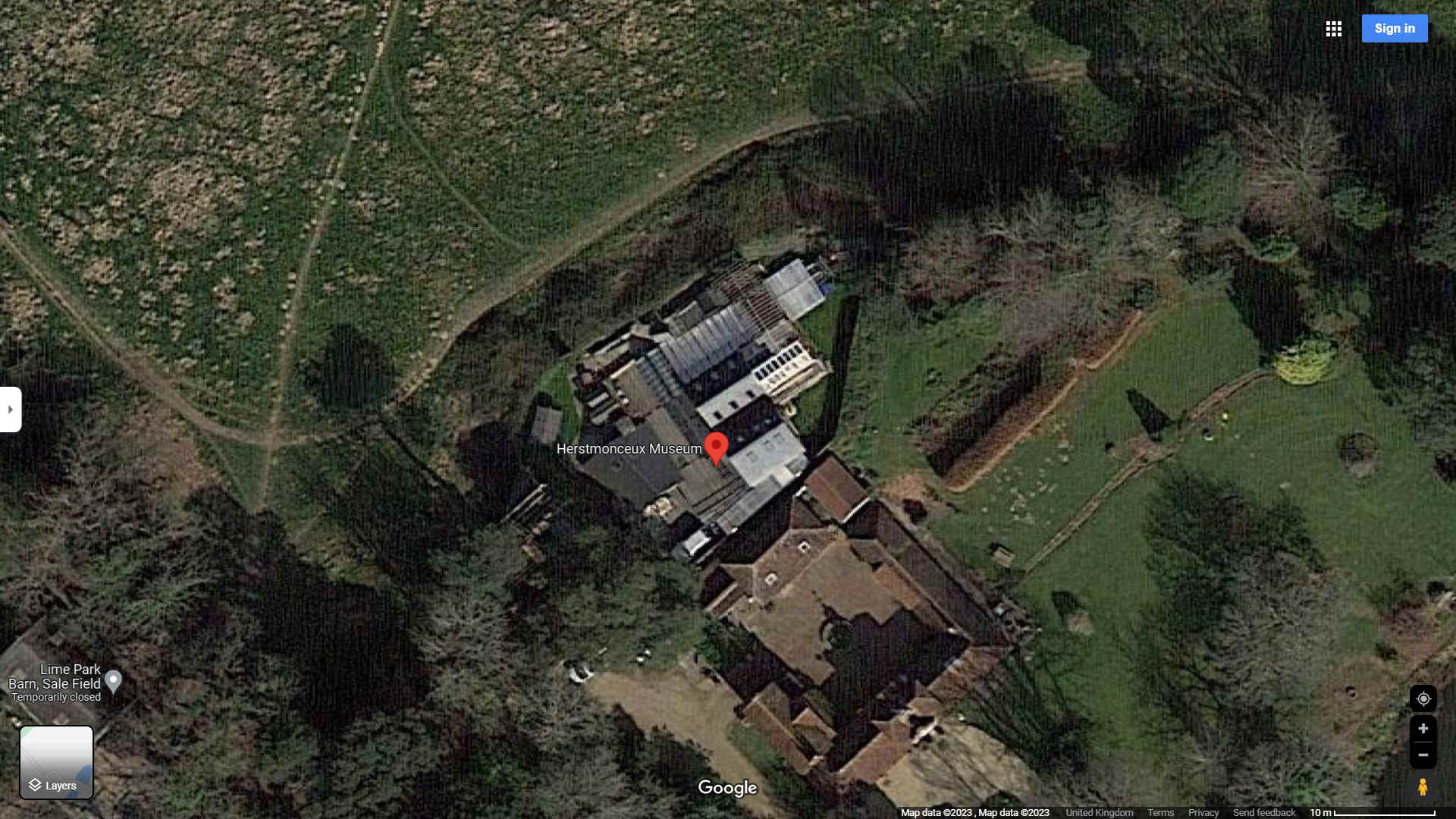
An
aerial view of Herstmonceux Museum in 2022, showing the public footpaths
north of the generating buildings. Many of which are unregistered, but
well trodden for over forty years, from our records.
AFFIDAVIT OF
RONALD SAUNDERS
_____________________
I Ronald Saunders, of 'Windy Mead', Potmans Lane, Lunsford Cross, near Sidley, Bexhill in the County of East Sussex, TN39 5JL, do solemnly and sincerely declare as follows :-
1. I make this affidavit in respect of land and buildings in Lime Park, Herstmonceux and the Herstmonceux area, to the best of my knowledge and recollection.
2. I was born at Rocks Cottage, Herstmonceux, East Sussex in 1921. I went to school in Herstmonceux village. The headmaster was Mr Bridgen. My favourite master was Mr Smith, who taught market garden and sports.
3. I have lived in Sussex all of my life. I lived in and around Herstmonceux until 1939 when I moved to Lunsford Cross. I have worked as a Nurseryman and Market Gardener all my life. I have a good local knowledge of the area.
4. My father, Albert Saunders, worked for Baron De Roemer at the turn of the century. He was the Chief Engineer at
Lime
Park. He also owned the properties in Lime Park and the park itself. My father's duties mainly involved the running of a steam-powered generator and energy storage facility in Lime Park.
5. The steam powered installation comprised of three large rooms or sheds. Two of these sheds remain and can be seen today. As can the concrete generator mountings which were located in the room to the rear of the building, now removed. The building was clad internally and externally with pine matchboarding. Large timber trusses supported the roof. The rooms were divided by walls which, were lined with tongue and grooved boarding. The sceilings were also boarded and on the upper level there were opening window vents in each loft area. I do not remember the garage section with the inspection pit, although it is has been there for some time.
6. Accumulators, were stacked in the room section nearest to the stable
yard. These accumulators were arranged for daily inspection and maintenance. Maintenance included checking terminals and watering the cells to make up for losses during charging. Other maintenance included oiling and greasing the steam
[gas] engine bearings. It was a full time occupation.
7. My father would start the steam [gas] machinery at 7:00 (am) o'clock every morning and stop the machinery every afternoon at 5:00 (pm) o'clock. Coal was burnt
[converted using pyrolysis] in the boiler fires [pyrolysis chamber] to make the
steam [town gas]. During this time the engines would turn generating machinery in order to charge the accumulator banks. The
electricity so stored would be used during the remaining hours, so as to provide a continuous supply of electricity for the park. Excess energy was sold to selected village users during the day. I believe this included the butchers and it might have also included the early cinema, near the fire station later on.
8. Water was raised from wells on site to supply the steam machinery. This well was permanently plumbed in to the equipment so as to raise water.
Water was also supplied to the market garden at the side of the main house and to the stables next door. The valves remain on site.
9. Another steam engine installation was run at Herstmonceux Castle. It was very similar to that in Lime Park. Eventually, around 1920, mains electricity became available at Herstmonceux. There was no longer any need to generate electricity on site. The new mains electricity was quieter and more convenient. At that time, the steam engine and generating machinery from the building in Lime Park was moved to the Castle. My father helped with the move and then continued to work at the Castle, instead of Lime Park, for Colonel Lowther.
10. Steam powered generating was common in those days. I remember that at Bodle Street Mr Barnes had three traction engines. He would travel to local farms and do the thrashing for them.
11. I left school at the age of thirteen. At this time I continued to live at Rocks Cottage in Victoria Road, not far from the Monkey Puzzle. My first job was at the Horseshoe Inn.
12. I helped out generally at the Horseshoe Inn [now demolished]. My main task was tending the chickens. This included feeding, watering and collecting eggs. We also made our own butter and cider. The remaining time was made up in the gardens.
13. I started work for Mrs De Roemer around 1936. I was fifteen. Mrs De Roemer lost her husband during the
First World
War. She was single. I worked under Mr Stapley, the head gardener, together with Mr Ransom. Mr Ransom was deaf and dumb. We communicated with Mr Ransom using sign language. I remember that Billy Medhurst could understand the sign language best. Billy was the under gardener.
14. My wage was 10/6d per week. I only worked at the park for a year. If I had stayed longer my wages would have gone up to 12/6d. It was the practice in Lime Park to bring in new persons at the lower amount, rather than pay the extra 2/-. I took Roger Watson's position and when I left Nobby Clark followed me.
15. I remember the old generating rooms. When I worked in the park the building was covered in corrugated tin. This tin had been added, so I understand, to reduce the risk of accidental fire. The main left hand shed (as you went in from the park drive) was empty of machinery. Only the concrete mount remained, with the
steel bolts that held the engine in place. The floor valves were still there and all the old plumbing and pipe-work. The main right hand shed still had the accumulators arranged in stacks all the way to beam height (8ft) around the sides of the room.
16. There was a stable next door with a garage. This has now been added to with a house extension. It is now known as
The Old
Rectory. The stables were always empty of horses. Instead, Mrs De Roemer garaged her
Armstrong Sideley motorcar there in two converted stable units. The yard was brick laid in a large square shape. The door under the wooden tower section was where we sat to pluck poultry. We used part of the stable block on the left as you go in, to prepare seed boxes.
17. Mrs De Roemer had a chauffeur, Mr Green, who lived at the end of the lane near Gardener Road, in the lodge. I remember that Eddie Simmons would repair cars at
Windmill
Hill. They also served petrol. His father was the blacksmith from the same site as the garage building. My uncle, Mr Delves was the local blacksmith for Herstmonceux village. He married my father's sister.
18. We would chop and saw wood for the main house. The wood was stored in various parts of the stables and in another shed in front of the generating sheds. This building was also used to store dried bundled branches or faggots, for lighting the fires of the main house.
19. Behind the generating shed buildings was a pig house. To get to the piggery, you went through (what later became the faggot store) into the back yard, and past the coalbunker set in the hillside. The piggery was divided into two sections. The front section had a gate about four feet high. The back section was covered over for protection as the sleeping quarters. One part was for the sow and as she had her young, they were transferred into the other section. There is now a
Second World War bomb shelter set into the hillside past the coalbunker where the piggery was.
20. Mr Stapley lived in the Lodge at the entrance to the park from Chappel Row (Church Road). Two of us would sweep the drive all the way to the main house from East Lodge with birch brooms. We would also sweep the drive coming into the park from the other end at Gardener Street. The leaves would be piled on a leaf mould pile opposite the Lodge. We would then mix this mulch with soil for seeding.
21. We grew vegetables in the market gardens past the main house. Billy Medhurst would regularly carry two boxes of sweet peas across the field to the top gate and past the sports field, to a bus in the village, which, went to
Hastings market.
22. I remember that Mr Harmer ran the windmill at Windmill
Hill. He had a bakery. Mr Weaver was the head baker. We bought bread from him on Saturdays. As a lad I would sweep his bakery rooms after the days baking. As a reward he would bake me a special small loaf with a round top. At the end of the drive to the windmill, near the cottage building, was an entranceway let into the bank. This went down steps that led into a tunnel passage. This passage was said to go all the way to dungeons in Herstmonceux Castle. I only went a short distance into this passage before it became too dark to go any further. Because of this I cannot confirm where it comes out.
23. Eggar Curtis owned a Butchers in the village. He also owned a Brewery about half way up West End past the Woolpack public
house [to become Geo's
Coffee House]. Mr Curtis later built a dance hall next to the fire station. And later still he added the Cinema. I went to this cinema most Saturday nights. It cost 4d, and I used to smoke Woodbines on those occasions, which cost another 2d. I later gave up smoking.
24. When I left the Von Roemers, I went to work at Cowdown Farm for Mr Lindsey.
25. My parents are buried in the Church next to Herstmonceux Castle and my daughter Shirley lives locally at Watermill Lane. She was born in 1948.
26. I can confirm that Italian prisoners of war were kept in a camp put up on the football green close to
Lime
Park. This camp has now gone, but football is still played on the green.
27. I make this affidavit conscientiously believing the same to be true and I attach copy of an Ordnance Survey based site plan to confirm the general layout of Lime Park as I remember it, as an exhibit.
Sworn by the said Ronald Saunders
.........
before me
....
Solicitor/Commissioner of Oaths
at
.. in the County of East Sussex this
.. day of July 1997.
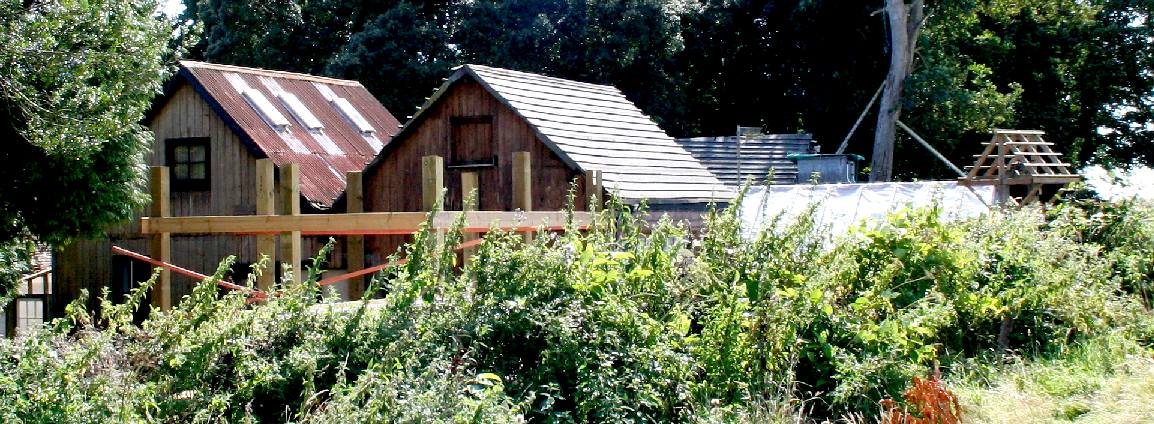
Ron was kind enough to put his information in a form that would be legally recognized. He also
accompanied Vic to Lime Park to show him first hand what each part of the building was used for. It might have been a bit confusing for Ron, because one rear section of the building was missing. The curator at the Amberly Museum would later clear up this part of the mystery for us, but some of the information provided by Ron may not be one hundred percent accurate, because we know that the de Roemers again generated electricity from the Lime Park generating station around 1936. This is documented in a respected electricity publication. Thus, much of the machinery must still have been in-situ at the time that Ron recalls, and
we wonder if he ever went into the third section, which would explain why all the
batteries were still in evidence.
We
also know, that the engine was not powered by water vapour, as steam, it
was a gas engine, according to an article in Seeboard magazine. It is
though very easy to confuse the two, as a gas engine still requires
coal, to make town gas, and the reciprocating machinery looks very much
like the equivalent steam engine. They even make similar sounds in
operation.
Despite the odd error in interpretation Ron was able to tell a great deal about the artifacts on site, which
were later verified with other sources. Margaret Pollard would later confirm much of Rons recollections, Archaeology South East filled in other blanks during their survey
in 1999 and finally another member of the public living in Brighton or
Hove, took the trouble to donate the original framed instructions copy of which is seen
elsewhere on this website. Very public spirited of him and his family,
with our grateful thanks.
With so much evidence now available to confirm the history attaching to this interesting complex, it makes
us smile each time we think of the local council arguing quite persuasively at public inquiries and before high court judges, that
Vic was mistaken about the generating buildings. Alas, this is not a
comedy and what is perhaps not so amusing is the near half a million pounds of ratepayers money that has been wasted
trying to prevent anyone gaining recognition for the complex since 1982. And,
that even today in 2023, the complex still does not benefit from a recognised
planning use. Thus, up to 2017 could not afford to repair the roofs or otherwise treat the
exterior - which is still in need of a great deal of attention, and
constant maintenance. Over the years, many locals have asked why
restoration is taking so long. If you are reading this, you may
understand that we cannot impart the details in a short conversation and they probably wouldnt believe
what they were hearing if not fully corroborated. That is the nature of
gossip and rumor-mongering, even if they mean well. So we just shrug.
It was though at that time, the duty of all local authorities to find a reasonable use to give owners of historic buildings in need of repairs, the means to do so. It
was also the duty of councils to consult with the County Archaeologist and then English Heritage, according to Planning Policy Guidance notes 15 and 16. But, and
we're sure you wont be surprised to learn, that the local authority skipped that vital stage. The reasons for this come into sharp focus in
later in this story, where a local action group had secretly recorded a meeting of the planning committee
who were discussing one of Victor's applications. We wont go into that here because
it might spoil the nice part of the discovery process for you.
If it had not been for Alex operating a mobile sewing machine repair
service across Sussex, Victor
would never have met Ronald Saunders, and you would not be able to read
his recollections. Big thanks then to Ron for taking the time to share,
and for Alex, for putting the two in touch.
https://
CHARACTERS
If
you know of any information that may help us complete this story, please get in
touch.
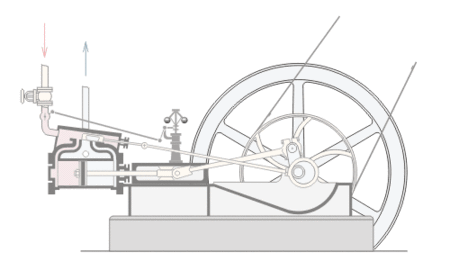
|
